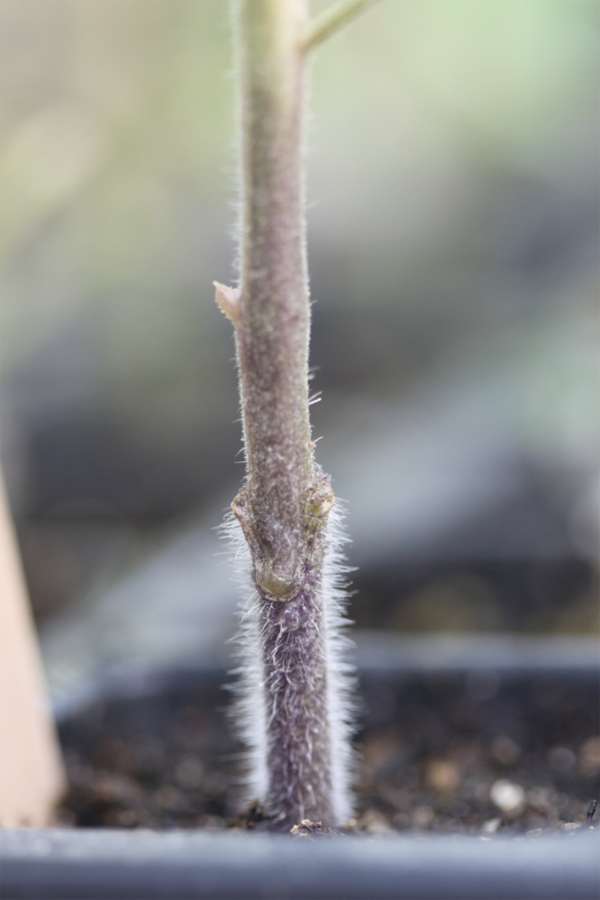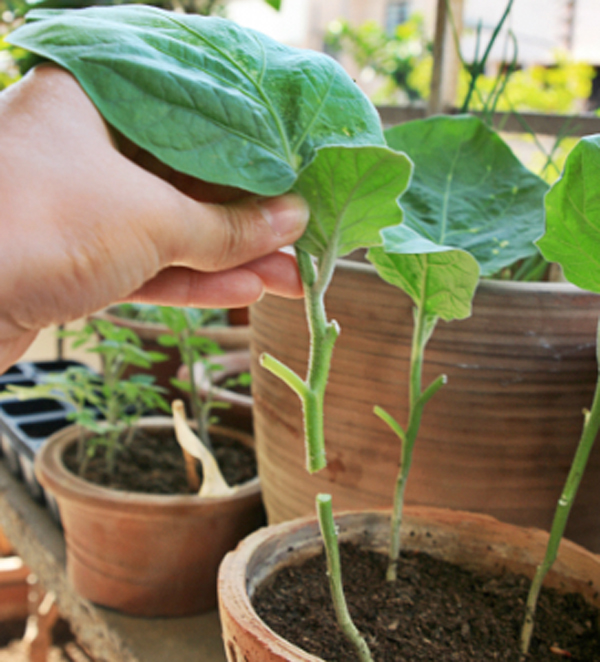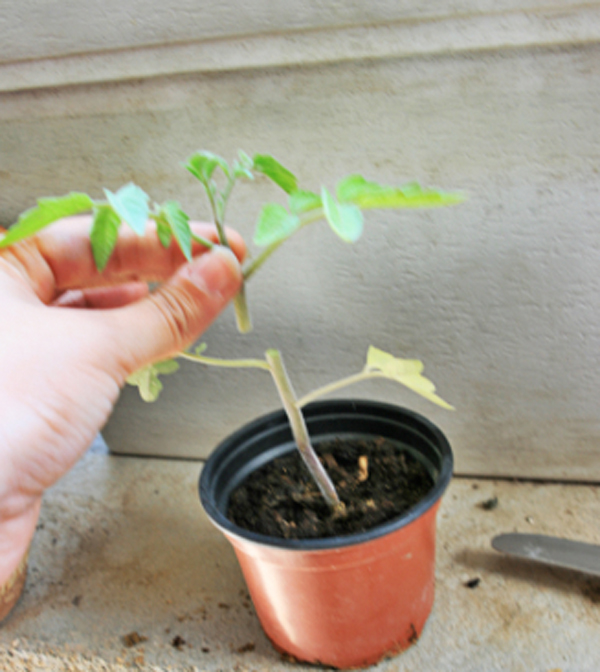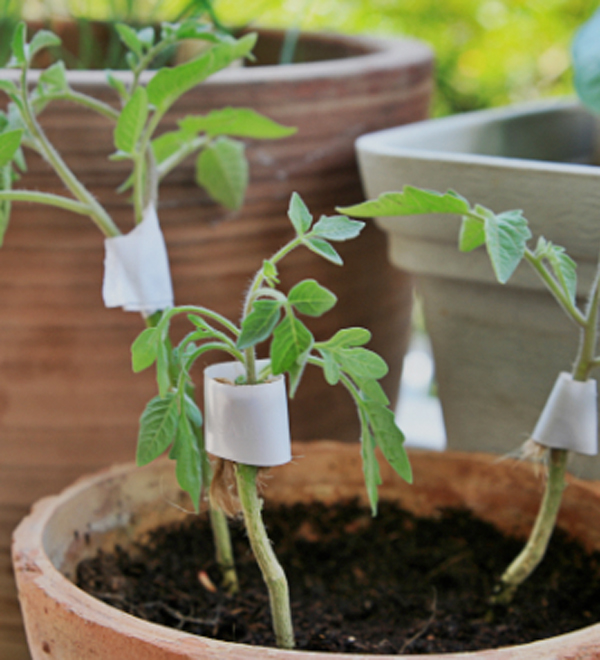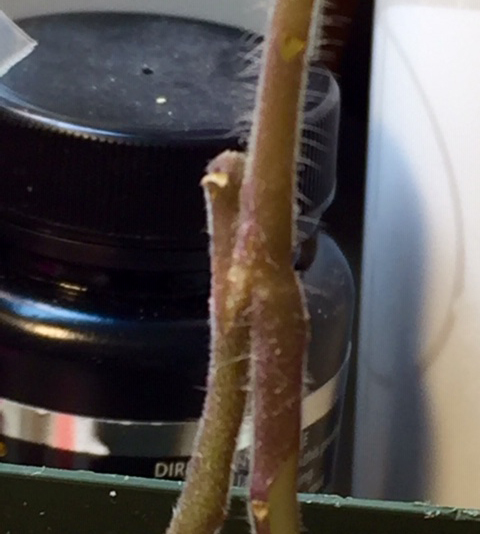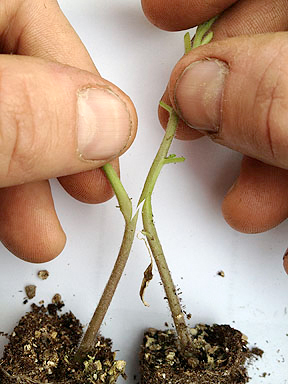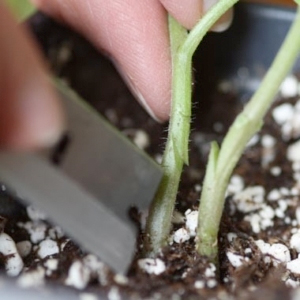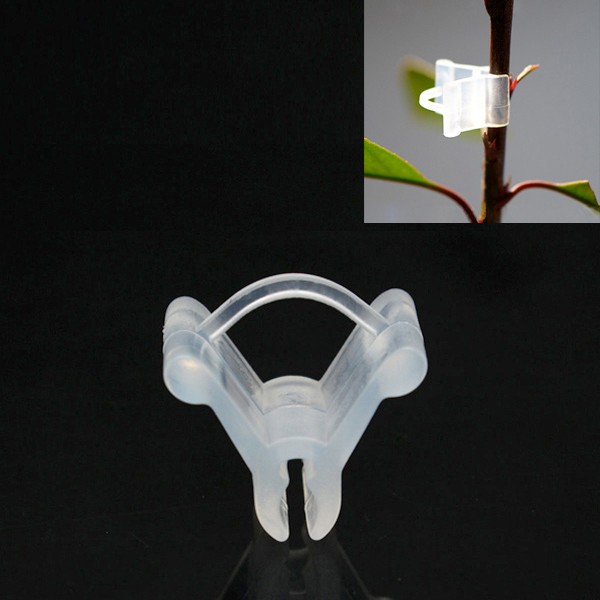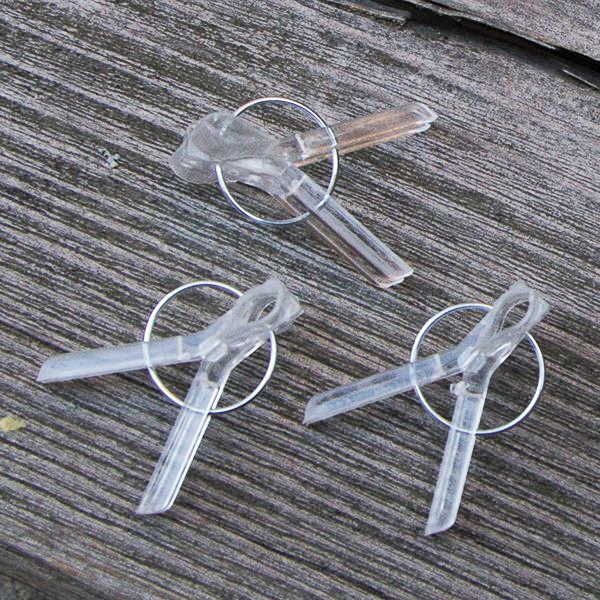
Chapter 38
Grafting Tomatoes
Grafting is a technique used by growers wherein a tomato variety with desirable above ground horticultural characteristics such as taste or fruit size is spliced to the roots of a tomato variety with valuable underground characteristics, such as resistance to soil-borne diseases and vigorous root growth.
The top of the selected tomato plant, the fruit producing portion, is called the scion. The scion is totally removed from its original plant roots and grafted onto the root portion of a different variety called the rootstock. Any heirloom variety could be used as the scion, but giant tomato growers select scion varieties that grow large tomatoes with a tendency to produce fused blossoms. Rootstock varieties are fewer in number and have been selected especially for resistance to soil-borne diseases and increased root vigor. The most commonly used rootstock variety is Maxifort. This variety increases water and nutrient uptake in grafted plants. This results in bigger tomatoes. Research has demonstrated that grafted plants produce increased yields in comparison to normal plants.
Scions and rootstocks are grown from seeds using techniques described elsewhere in
this book. Seeds for grafting will need to be started several weeks before seeds for regular plants as the grafting process adds about 2 weeks to the process of going from seed to garden plant. To achieve a successful graft, the scion and rootstock stems must be the same diameter. Since different tomato varieties require different germination periods and grow at different rates, seeding times may need to be adjusted to grow the different varieties to the same stem size. Stagger plantings to offset the variation in germination times between rootstock and scion varieties. Plant a few seeds of each variety (scion and rootstock) to determine the germination times. If seedlings have already emerged and either the scion or rootstock is too large, you may decrease the environmental temperature to slow the growth of the variety that is ahead of schedule. As the seedlings grow expose them to full sun and some water stress to keep the plants short and to increase their tolerance of water stress. Avoid excess fertility in your potting mix so that the plants are not too lush.
Grafting techniques used by tomato growers include top grafting, cleft grafting and side grafting. Top grafting will be described here as it is the simplest technique and as it requires only a single cut on the scion and the rootstock plant. Also the technique can be used on small plants.
When grafting, try to make your grafts early in the morning or late in the day when transpiration is decreased to avoid water stress. Make your grafts in a shaded spot and out of any wind. Indoors is best. Do only one graft at a time to avoid cut ends drying out and wilting of the scion. Immediately before grafting make certain the plants have been watered and that turgor is good. Water and/or mist the plants right after grafting.
With top grafting the scion is completely removed from its roots and placed on top of the rootstock stem. To begin grafting, select scion and rootstock plants that have the same stem diameter. There is a narrow range of plant size for grafting. The ideal size for top grafting is when the stems are about 2 mm in diameter. Plants this size are usually about 4 inches tall and have 4 to 5 true leaves. It is physically difficult to graft plants that are less than 2 mm in diameter and the success rate declines rapidly as the stem diameter increases. The scion and the rootstock need to be the same diameter for proper healing to occur as the vascular tissues in the stems must align properly.
After the scion has been selected, using a sharp razor blade, remove its first set of true leaves to reduce transpiration during the healing process. Leave only the uppermost few leaves. Leave the cotyledons in place. Then, cut off the scion from its roots just below the cotyledons, at about a 45 degree angle. Discard the bottom of the plant. Cuts on the scion and rootstock must be made at the same angle so that they will fit together and the vascular tissue will align properly.
Next take the rootstock plant and cut off the top just above the cotyledons at exactly the same angle the scion was cut. Remove the cotyledon leaves. If the rootstock plants are too small the scion cut may be made higher and even above the cotyledons where the scion stem is smaller. The two stems must be the same size if proper healing is to take place. Discard the top of the rootstock plant.
Top grafting relies on a tiny plastic sleeve that holds the scion and the rootstock together until it heals. Slip the plastic grafting sleeve onto the rootstock stem and then gently push in the scion stem so that the cut surfaces make full contact. You may have to wiggle the scion stem gently if needed to get a good fit. The idea is to maximize the chances for the vascular bundles of the scion to come in contact and align with the respective tissues of the rootstock. It is very important for healing that the cut surfaces match in diameter and align properly.
Proper healing and acclimatization are very important if the grafted plants are to survive. Immediately after the grafts are made the plants must be protected from wilting until the cut ends heal together. Because the scion has been separated from its root system, it will tend to wilt in the first few hours after grafting but in a successful graft it will slowly regain its turgor. Keep the plant in a place where it is warm (75 to 85 degrees) and moist (90 to 95 % relative humidity) while the cut ends heal together. This usually takes 3 to 5 days. Keep the plant in a heavily shaded area during this time. The use of a plastic dome over the plant will help to control humidity. A water pan inside the dome or a light misting several times a day as needed also helps. After a few days the successfully grafted plant will regain its turgor while one that has not been successful will wilt permanently.

After 4 to 5 days at high humidity levels without sunlight, the plant should show no evidence of wilting. At this point the plant must be acclimatized to conditions in the garden. Light can be slowly introduced and humidity levels slowly reduced over the next week. Do this slowly and carefully, increasing the light and decreasing the humidity a bit each day. Watch your plant closely for wilting. Start with a few hours of light early in the morning and late in the day. Slowly increase the amount of time per day that the plastic dome is open until you can finally remove it. Mist the plant as necessary during this time to prevent wilt.
As the grafted plant grows, the grafting clip will expand with the growing stem and will eventually fall off. After a total of 2 weeks the grafted plant can be cared for similarly to a regular tomato plant. When the grafted plant is finally placed in the garden be sure that the graft union is well above the soil level. Monitor the plant so that no suckers form below the graft union. As the main stem grows, allow a second main stem to form and grow as well. Then treat the plant the same as you would any other plant.
Grafting clips and rootstock varieties are available from Johnny's Selected Seeds (Johnnyseeds.com) and Hydrogardens (hydro-gardens.com). A nice video on grafting is available Johnny's Selected Seeds.
Grafting Timetable Day Activity
- Day 1 rootstock seeds are planted
- Day 3-5 scion seeds are planted*
- Day 10 plants emerge
- Day 10-17 plant growth
- Day 17 grafts are made
- Day 17-22 plants are in healing chamber
- Day 22-29 plants are being acclimatized
- Day 29-36 plant growth and hardening
- Day 36 plants go into garden
